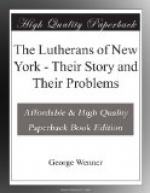In view of the complicated character of our membership it will not be an easy task to reconstruct our statistical methods. But it is evident that our missionary and evangelistic work will be greatly furthered when we have exact information in regard to our parochial material. Our figures should include every soul, man, woman and child, in any way related to our congregations, classified in such a way as to show clearly in what relation they stand to the church. A church that does not count its members as carefully as a bank counts its dollars is in danger of bankruptcy.
Church bookkeeping ought to be taught in the Theological Seminary. But if the pastor himself is not a good bookkeeper, almost every congregation has young men or young women who are experts in this art, who could render good service to the church by keeping its membership rolls.
Complete records are especially necessary in our great
city with its constant removals and changes of population.
The individual is like the proverbial needle in the
haystack, unless we adopt a method of accounting not
only for each family but for each individual down to
the latest-born child.*
In order that I may
not be as one that beateth the air, I venture
to suggest a method of laying the foundation of records
that has been helpful in my own work. I send
to each family a “Family Register” blank
with spaces for the name, birthday and place of birth
of each member of the family. The information
thus obtained is transferred to a card catalogue in
which the additional relation of each individual to
the church and its work is noted. In this way,
or by means of a loose-leaf record book, available
and up-to-date information can easily be kept.
When important records, such as synodical minutes, are printed, several copies at least should be printed on durable paper and deposited in public libraries where they may be consulted by the historian. Ordinary paper is perishable. Within a few years it will crumble to dust. The records might as well be written on sand so far as their value for future historians is concerned.
Congregational histories, pamphlets or bound volumes, jubilee volumes and similar contributions to local church history should be sent to the publlic libraries of the city and of the denominational schools.
In search of recent information the author consulted the card index of the New York Public Library. He found only nine cards relating to Lutheran churches. And yet we wonder why our church is not better known in this city.




